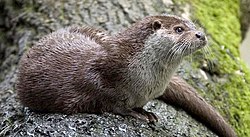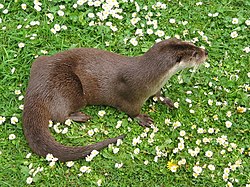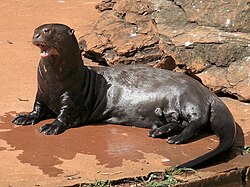| Otter Temporal range: Middle Miocene to present [1] | |
|---|---|
 | |
| Eurasian otter (Lutra lutra) | |
| Scientific classification | |
| Kingdom: | Animalia |
| Phylum: | Chordata |
| Class: | Mammalia |
| Order: | Carnivora |
| Family: | Mustelidae |
| Subfamily: | Lutrinae Bonaparte, 1838 |
| Type genus | |
| Lutra Brünnich, 1771 | |
| Genera | |
Otters are carnivorous mammals in the subfamily Lutrinae. The 14 extant otter species are all semiaquatic, both freshwater and marine. Lutrinae is a branch of the Mustelidae family, which includes weasels, badgers, mink, and wolverines, among other animals.
Contents
- Etymology
- Terminology
- Life cycle
- Description
- Feeding
- Species
- Extant species
- Extinct taxa
- Relation with humans
- Hunting
- Fishing for humans
- Attacks on humans
- Religion and mythology
- See also
- References
- External links
Otters are distinguished by their long, slim bodies, powerful webbed feet for swimming, and their dense fur, which keeps them warm and buoyant in water. They are playful animals, engaging in activities like sliding into water on natural slides and playing with stones.
Otters exhibit a varied life cycle with a gestation period of about 60–86 days, and offspring typically stay with their family for a year. They can live up to 16 years, with their diet mainly consisting of fish and sometimes frogs, birds, or shellfish, depending on the species.
There are 14 known species of otters, ranging in size and habitat preferences, with some species adapted to cold waters requiring a high metabolic rate for warmth. Otter-human interactions have varied over time, with otters being hunted for their pelts, used in fishing practices in southern Bangladesh, and occasionally attacking humans, though such incidents are rare and often a result of provocation. Otters hold a place in various cultures' mythology and religion, symbolizing different attributes and stories, from Norse mythology to Native American totems and Asian folklore, where they are sometimes believed to possess shapeshifting abilities.








